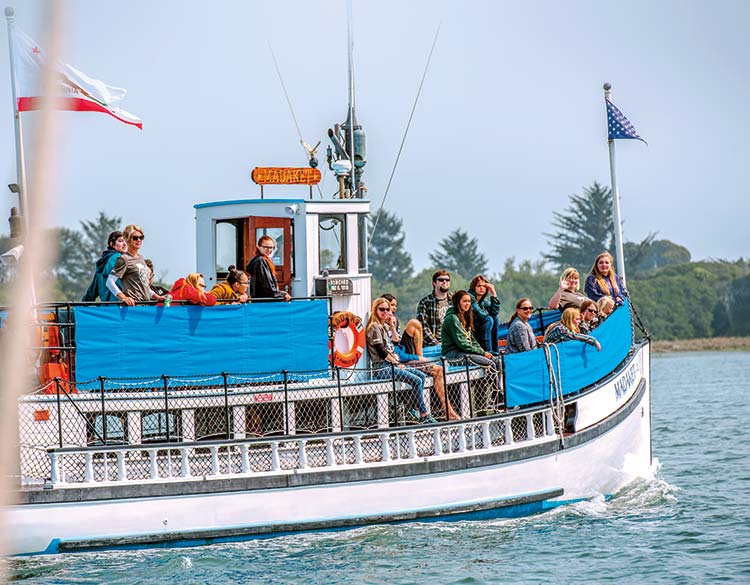
SAYING GOODBYE to family and friends, and leaping into the swirl of new faces, places, expectations, and responsibilities has long been seen as a rite of passage for students starting their freshmen year at college. “At first I was excited … When my dad dropped me off, I got nervous,” recalls Environmental Resources Engineering Junior Sabrinna Rios Romero, who left her home in Dallas, Texas, to attend HSU in 2016. Over the years, scholars have come to realize that the hurdles of starting college—social, cultural, academic, and personal—can have negative effects on students and their ability to succeed, as well as their desire to return to school.
In response, HSU launched several learning communities where first-year students explore a specific theme through multidisciplinary courses. The point of the programs is to immerse students in their studies and provide an instant support network of other students, faculty, and staff. They also have the opportunity to live together. It’s an important University effort to enhance students’ sense of belonging and improve success for historically underrepresented students.
Ultimately, HSU hopes learning communities can help it reach a major goal of better serving students of color, low-income students, and first-generation students. This is a challenge across the state and nation, and it’s a focus of the CSU system’s Graduation Initiative 2025.
A cruise on Humboldt Bay and overnight stargazing trip give learning community students an opportunity to get to know each other, their faculty, and Humboldt County.
Early reports show HSU’s first place-based learning community has made a big impact on its first cohorts of students. This and other early communities were funded by grants that focused on increasing the success of underrepresented students in science, technology, engineering, and mathematics (STEM). As the programs continue to mature, their architects have helped develop other learning communities—in the sciences, and beginning this fall, in arts and humanities.
THE KLAMATH CONNECTION
Learning communities aren’t a new concept, but Humboldt is putting a twist on the idea.
A student learning community is a curricular approach that intentionally links a cluster of courses around an interdisciplinary theme and enrolls a common cohort of students. Years ago, a team of faculty and staff visited Evergreen State College, recognized as a leader in student learning communities, to learn about how they might work at HSU.
That visit bore fruit when Professors Matt Johnson and Amy Sprowles, with initial funding from the CSU STEM Collaboratives grant program, launched HSU’s first learning community called the Klamath Connection. Designed specifically for incoming first-year students interested in natural resource and life sciences, the first cohort began in 2015. What sets the Klamath Connection apart is its place-based learning model. By framing much of the first year around the scientific, cultural, and political issues of the Klamath River Basin, the program connects students to the local area, and gives them a tangible grasp of what paths their careers can take.
Johnson, Sprowles, and their colleagues also recognized that many first-year students were overwhelmed. They thought HSU needed to do a better job welcoming them to the region, and also into the community of scientists.
First-year students largely come from the Los Angeles area and the Bay Area (40 and 13 percent in fall 2016, respectively). For many of them, the remote North Coast region can be geographically and culturally jarring.
Yet the North Coast also offers examples of people working to solve complex social and environmental challenges. By weaving place-based themes of the Klamath River, the Klamath Connection introduces new students to the area and its communities, while also providing real-world lessons that can be applied anywhere in the world.
The program is also designed to fundamentally reform the first-year experience by creating a community of students, faculty, and staff that explore what it means to be a scientist today. To foster that sense of belonging, the program includes the option of living with other Klamath Connection students.
“I felt lonely at first, so the living community was helpful in knowing you could go knock on doors,” says Rios Romero, who joined Klamath Connection in its second year. “And seeing the people you knew around campus made it feel more welcoming.”
Romero developed connections with professors, worked on real-world projects, found a community of support with other students, and got a basic understanding of issues facing the Klamath River. She now interns with the Schatz Energy Research Center.
“I met my best friend in Klamath Connection, and we live together off campus now,” she says. “We’ve been in lots of the same classes throughout.”
Maribel Perez-Espinal, a Biology senior with minors in Chemistry and Communication, took part in the Klamath Connection’s first year. When she decided to come to Humboldt to pursue her dream of becoming a neurosurgeon, her mom, who was single and had four other kids, told her she was on her own.
“The people I met and friends I kept became my family,” she says. She still had challenges coming to a place where there were fewer Latinos, especially in her field.
“It was difficult to establish myself, being friends with people of different races,” she says. “Where I came from was violent, and I was shocked by how inviting people are here. Even that took getting used to.”
By incorporating four “high impact practices” — methods recognized nationally to increase student success in college coursework—the Klamath Connection aimed to increase retention and academic performance in its first-year students.
Those practices include a summer immersion program, in which students arrive at Humboldt State early to participate in activities with their professors as well as collaborators and scientists from the Yurok and Karuk Tribes. One is a project on Klamath River water quality that is integrated into many of their first-year courses, a new freshman year seminar prepares them to be HSU science students, they are automatically enrolled in a series of gateway courses, and they have additional access to peer mentoring.
While the learning communities are new to HSU, they collaborate with other longer serving student support programs, such as HSU’s Cultural Centers for Academic Excellence and the Indian Natural Resource Science & Engineering Program (INRSEP), to make sure students are aware of these resources.
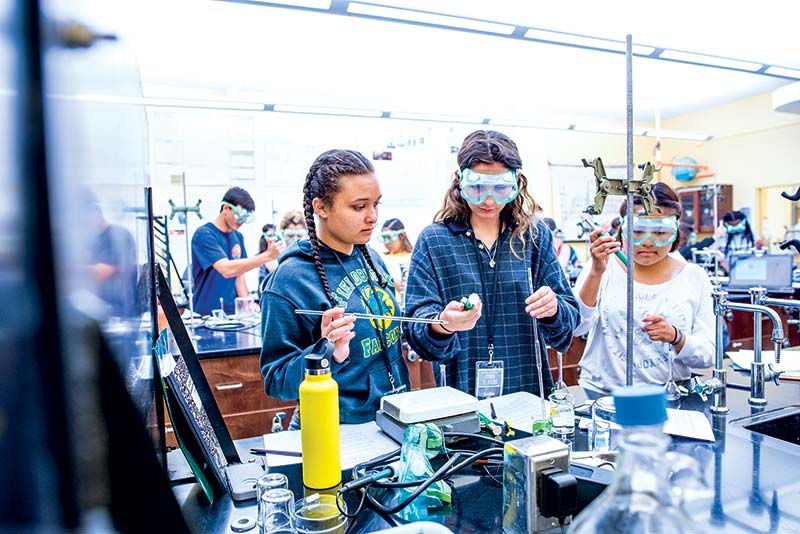
MEASURING SUCCESS
All indications show Klamath Connection has been a success. As the team shared at a meeting of the Association of Hispanic Serving Institution Educators, students from the first two cohorts of the program (2015-16 and 2016-17 years) reported a heightened sense of belonging, community, academic skills, and attitudes when compared to other freshman in their majors.
They scored higher in nearly all first-year core science, math, and GE courses, had higher overall first-year GPAs, completed more units toward a degree, and had increased retention into the sophomore year (84 percent vs. 72 percent), according to the report. Gaps for underrepresented and first-year students almost disappeared in the first semester Botany course, first-year GPAs, and units completed toward degree.
Through the community of the Klamath Connection, Perez-Espinal began to gain the sense of belonging and confidence. She says knowing that the program was created specifically to help underrepresented students in the sciences made it easier to accept that the professors cared about social and cultural gaps in her field.
“In science, cultural differences aren’t as emphasized,” she says, but she’s been able change that on a small scale. She now works on two research projects, studying sudden oak death genetics. She says she is comfortable talking with her research mentors about her experiences as a Latina woman. “We talk, they want to understand if something is making me uncomfortable,” she says. “Sometimes actions and words are misconstrued — it’s an opportunity for constant and open dialogue.”
She attributes her current positions and her opportunity to talk openly with her mentors to the program as well. “The hands-on experiences of the Klamath Connection gave me the confidence to apply for research jobs.”
While early indications show that Klamath Connection is improving the learning environment and success of underrepresented students, Johnson is quick to point out caveats of their early results and emphasize that more work needs to be done. For one thing, the programs are still young. They continue to work to make the programs more effective, and after this year will be able to see how Klamath Connection students compared to their peers over the course of four years.
In addition, students have said they continue to face institutional barriers to their success—on campus, in the classroom, among their peers, and within the greater Humboldt community.
Many students outside the programs do not yet feel the benefits of the place-based learning communities, Johnson adds. “We need to work harder to accelerate our transition from a Hispanic-enrolling institution, to a truly Hispanic-serving institution, and on to a Hispanic-thriving institution.”
Johnson says the Klamath Connection has helped professors in fundamental ways as well. Students meet professors much earlier in their academic journey, making instructors more connected with the cohorts and entire campus community.
NEW COMMUNITIES
The promising results have led to an expansion in learning communities across campus. In 2017, Stars to Rocks was started for incoming Chemistry, Geology, and Physics & Astronomy students. This year, a community called Rising Tides began for Marine Biology and Oceanography students.
Some of these learning communities have been supported by a $3.9 million grant from the U.S. Department of Education aimed at increasing the number of Hispanic and low-income undergraduates in STEM. That funding has also expanded tutoring services, helped reform developmental math instruction, and helped create new pathways for transfer students from two-year institutions.
A $1 million Inclusive Excellence grant from the Howard Hughes Medical Institute (HHMI) awarded to Sprowles and Johnson in 2017 is helping expand the place-based learning communities and providing faculty with training in culturally responsive teaching practices, methods that help students harness their strength to better learn rigorous course material.
“Through our partnership with the HSU Center for Teaching & Learning and Escala Educational Services, we were able to offer workshops to nearly 100 HSU faculty members in the first year of HHMI funding, “says Sprowles. “As these methods become more widely used in our classrooms, we expect to see improved outcomes for all students, both in their coursework and in their future careers.”
Two communities in the College of Arts, Humanities & Social Sciences (CAHSS) began this fall: Students for Violence Prevention, which is available to any first-year student interested in non-violence and social justice; and Global Humboldt, a community for first-year students who haven’t yet declared a major.
While College of Natural Resources & Sciences learning communities have provided CAHSS with support and lessons, CAHSS Dean Lisa Bond-Maupin says that her college’s communities have unique strengths and challenges. There are many approaches to learning communities, she says. An important part of making each one successful is to model and adapt them to suit the needs of your students and strengths of your faculty.
Bond-Maupin is confident the instructors of Students for Violence Prevention and Global Humboldt will bring what is needed to the task. Faculty members in these programs have been meeting in their own professional learning communities, working to ensure the integrity of the academic aspects of the themed communities.
With help from Associate Dean Rosamel Benavides-Garb and a wide variety of department chairs and faculty members, the College has been developing Global Humboldt for two years, and will draw on the strengths of CAHSS faculty contributions to general education, interdisciplinary collaboration, and international education.
“Undeclared students are the most at risk of leaving,” Bond-Maupin says. “We began to recognize the need to serve undecided students, expanding their opportunities through the passions of the faculty.”
In addition to the community-building that will help students explore their career options with the support of their peers, they’ll get connected with specialized advising and mentoring. The coursework includes topics in food, culture, place, Native American studies, rural and urban economic development, art, and ocean-coastal environments, and will improve skills in communication and writing.
“We want to reframe ‘undecided’ as a strength, looking to students interested in creating and creativity,” says Bond-Maupin. Global Humboldt students will be automatically enrolled in these courses, to take away the added pressure of scheduling classes during what’s often a hectic first year for undeclared students.
The Students for Violence Prevention learning community grew out of HSU’s CheckIT program, which has been recognized nationally for its efforts to end sexualized violence. The program offers optional themed housing and guaranteed courses including “Composition and Rhetoric,” “Public Presentations,” “Power/Privilege: Gender, Sex, Race and Class,” and a weekend-long “Act to End Sexualized Violence” seminar. Students will attend social justice events, special programming, and retreats—gaining an understanding of the kinds of violence prevention work they can engage in at HSU.
“It’s an expression of the commitment of the college to the preparation of scholar activists,” Bond-Maupin says.
Global Humboldt and Students for Violence Prevention don’t contain the same level of place-based curriculum that the science learning communities do. Instead, Bond-Maupin says, the curriculum is grounded in the place-based work of our faculty and focuses on creating a sense of connection to help people commit to furthering their studies at Humboldt State.
“Faculty selection plays a role — we’ve identified faculty to teach in the learning communities that already use place-based learning components in the classroom,” she says.
Kerri Malloy, a Native American Studies instructor who has taught courses in Klamath Connection since its inception, is also the faculty coordinator for Global Humboldt and Students for Violence Prevention.
“I think of it as an ‘academic safety net’,” he says. “Through close connections with faculty and other students, we can identify if someone’s struggling, as well as their strengths. We can highlight their strengths and help out where needed. These things happen organically in a student community— this is more deliberate and faster.”
LOOKING AHEAD
Johnson, Sprowles, and Bond-Maupin see a potential future in which Humboldt State enrolls every first-year student in a learning community. The College of Natural Resources & Sciences is on track to have all first-year students enrolled in a learning community by 2020. HSU instructors plan to create two new communities: Among Giants for Biology, Botany, and Zoology students, and another for Mathematics and Computer Science majors.
Klamath Connection’s Johnson and Sprowles, and Place Based Learning Communities Director Katlin Goldenberg, as well as the faculty involved, have worked closely with colleges to develop the subsequent communities, and they continue to do so. Goldenberg and others on the Hispanic Serving Institution (HSI) STEM staff have written a “start up manual” for other colleagues interested in launching learning communities.
As more departments introduce learning communities, Goldenberg says the sharing of knowledge goes both ways.
“By bringing together minds from arts, humanities, and sciences we are better able to understand how to more holistically support our students so that they may succeed both personally and academically at HSU,” she says.
The key to replicating the success of Klamath Connection? “A group of faculty with a shared vision, not just a shared topic,” says Johnson.
But there are challenges. A major one will be funding for efforts beyond the sciences, which aren’t supported by the nearly $5 million in grants.
Creative thinking is needed as other departments move toward this model, but Bond-Maupin believes the will is there. She credits the commitment of key partners in areas like Housing & Residence Life, the Retention through Academic Mentoring Program, and the Academic & Career Advising Center.
“There’s a lot of excitement, energy, and interest,” she says. “It’s important to understand this as a cross-college exercise—learning communities will have courses from all colleges. We’re in it together.”
Those learning communities aren’t just made up of staff and faculty, of course. They include students like Perez-Espinal, who benefitted from the energy of the Klamath Connection.
“Klamath Connection was pretty much everything to me,” she says. “We stick through thick and thin. It helped us make it, not just academically but emotionally.”
Klamath
Successes
Since 2014, over 450 freshmen have enrolled in the Klamath Connection, the first of HSU’s new learning communities. The University has compared their success with hundreds of other HSU freshmen who are majoring in STEM disciplines but not taking part in a learning community.
Klamath Connections
students are…
8% more likely to report higher satisfaction with HSU.
13% more likely to say they made stronger peer connections.
15% more likely to report positive social aspects of on-campus living.
8% more likely to stay enrolled at HSU after their first year.
In addition…
- Klamath Connection students completed an average of 3 more units in their first year.
- An 8 percent “gap” in the first-year retention rate of Hispanic and their non-Hispanic counterparts in STEM majors was eliminated.
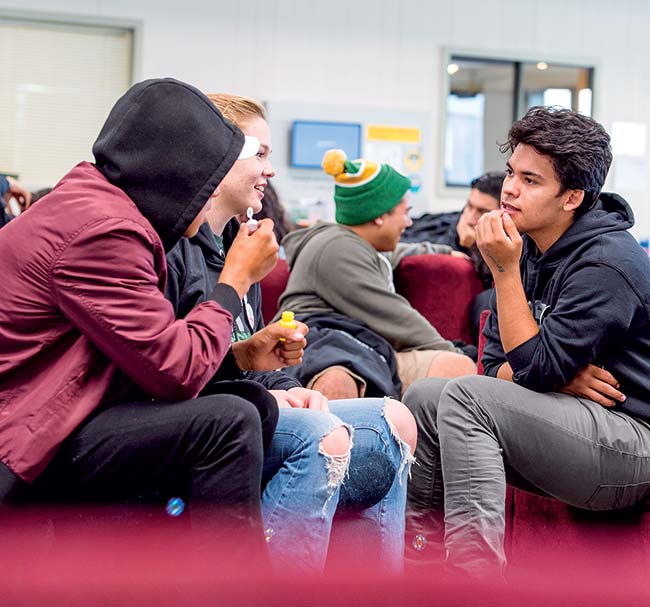
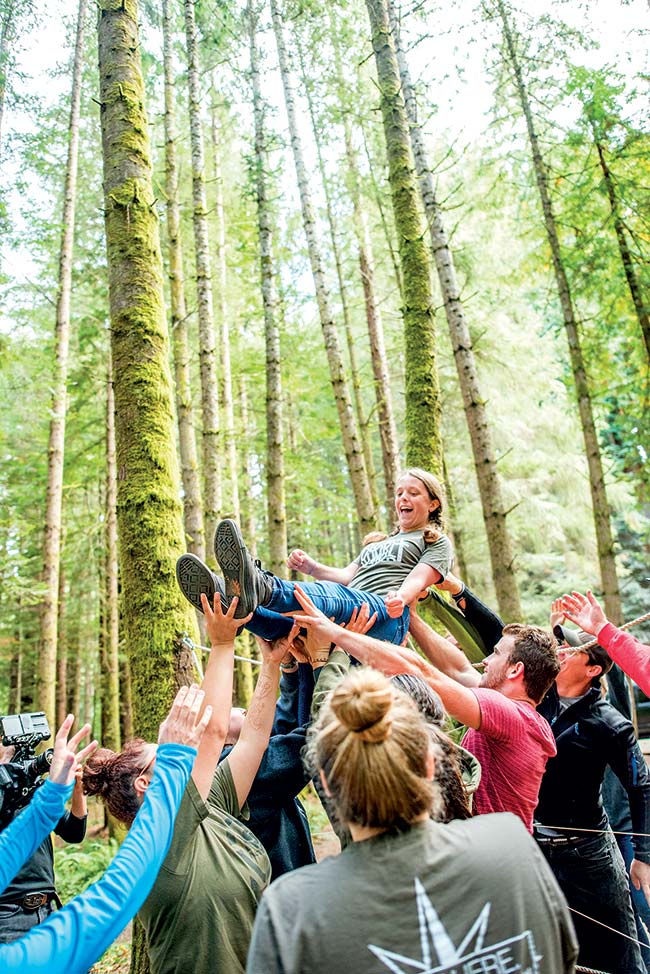
HSU’s learning communities bring first-year students together in inventive ways, focusing on feeling welcome in the local area, building relationships and good academic practices, and promoting an inclusive spirit. The approach has shown promise in student success rates.
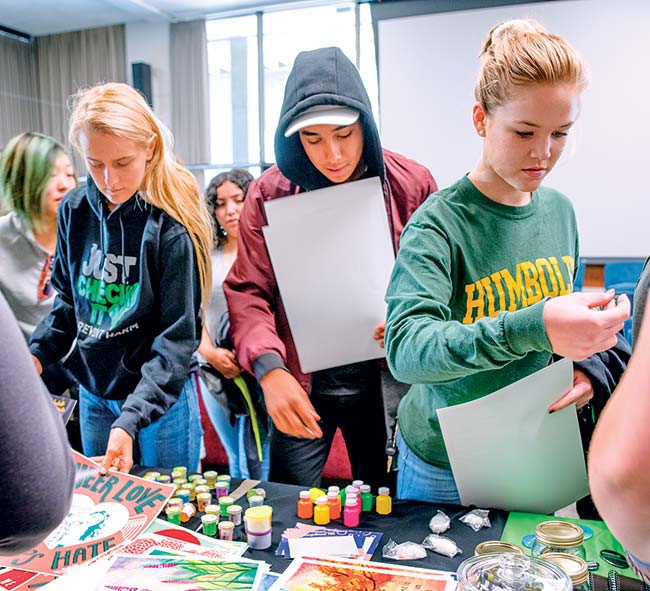
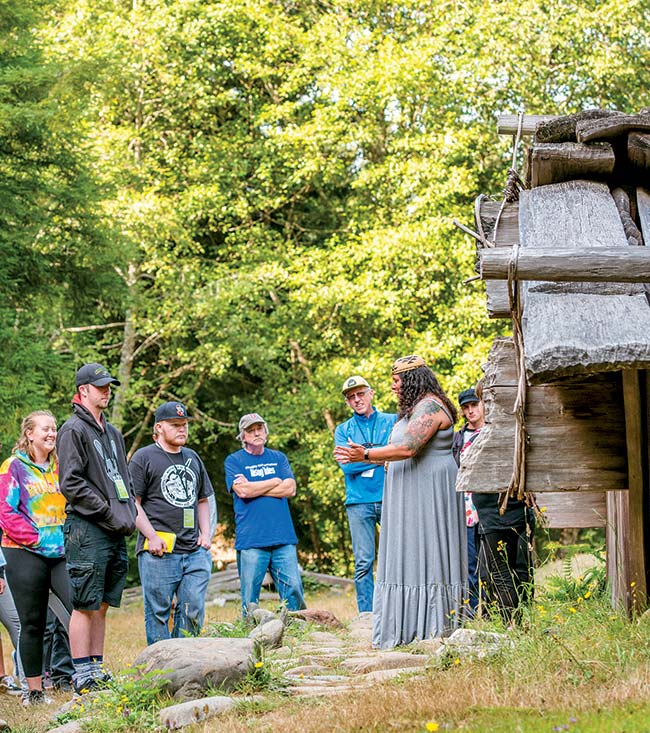
Several new learning communities launched this year—including two in the College of Arts, Humanities & Social Sciences. Meanwhile, the Klamath Connection, HSU’s first place-based learning community, is in its fourth year. The program has specifically sought to serve underrepresented students, who have reported a higher sense of belonging and show better retention rates, among other improvements.
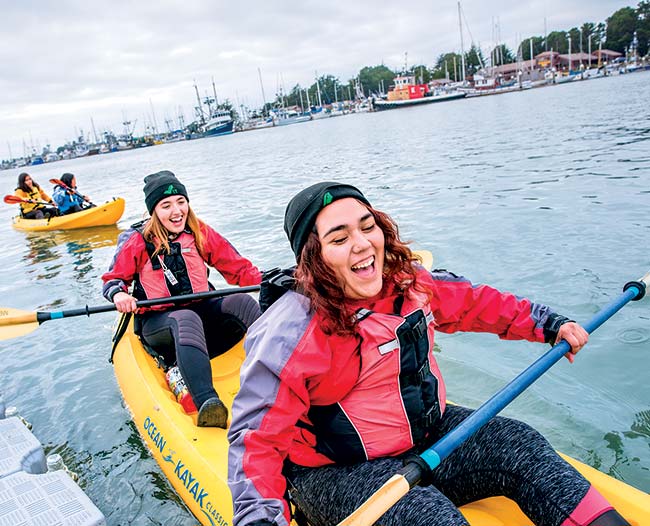
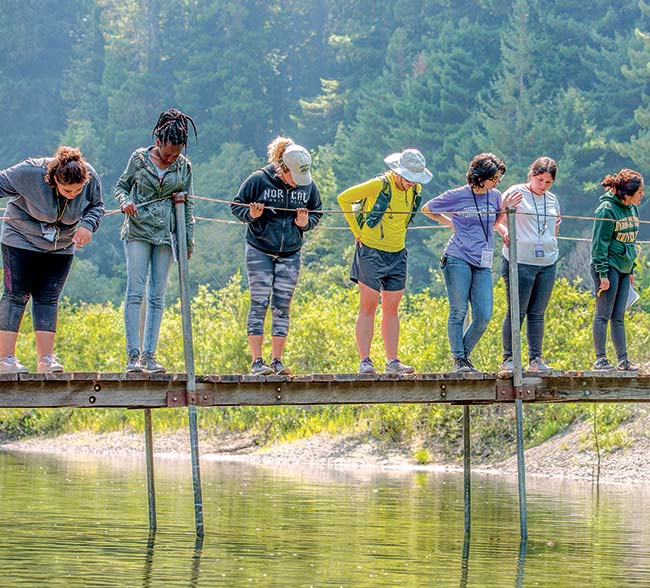
All College of Natural Resources & Sciences freshmen will be enrolled in a learning community by 2020. The key to replicating these communities, organizers say, is to adapt them to suit the needs of students and the strengths of faculty. Architects of these communities see a future at HSU where most first-year students are enrolled in a learning community.